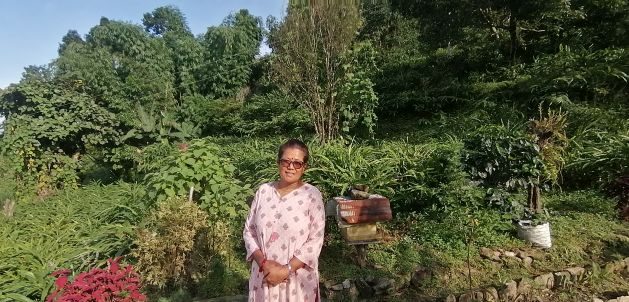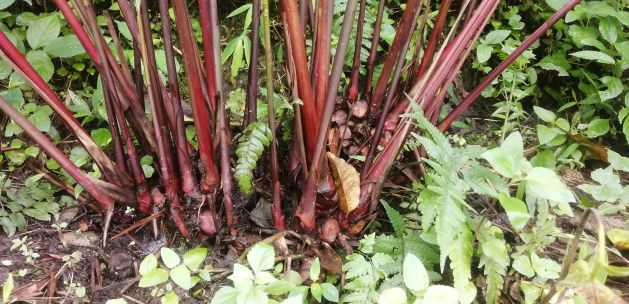Nepal Government, UN Agency Seek Investors for Latest Cash Crop to Boom in Country's East

SALAKPUR, Nepal, Sep 29 (IPS) - Two and a half hours’ drive north from Kakarbhitta, Nepal’s eastern-most border crossing with giant neighbour India, lies the hilly hamlet of Salakpur where lives Kaushila Moktan, a famed farmer of large cardamom.
“I run a homestay for guests visiting our village, I also grow green vegetables and do beekeeping,” said Moktan. “However, our biggest source of family income is alaichi (large cardamom, in the Nepali language).”
The plant has helped keep her family of three — including her husband and 31-year-old son —afloat, said Moktan. “This year we produced some 24 man (960 kg) of cardamom,” she added in an interview at her farm. “I have sold 5man for 160,000 rupees (Rs) (equivalent to US$1,229 ).”Locals have their own cardamom measurement. Forty kg equals one man. A man currently sells for about Rs 30,000.
Moktan has stored a large part of her harvest in hopes of a better price in the days ahead. “I have experience of selling 1 man for Rs 98,000 some six years ago. This time, the price has been reduced to around Rs 30,000.”
She added that beekeeping has improved her cardamom harvest. “This year, we fetched 30 kg of honey and 24 man of cardamom, but last year the cardamom harvest was just around 9 man and the honey harvest was 3 kg. I have seen that good pollination leads to better productivity both for cardamom and honey,” said Moktan.
Used as a cooking spice, large cardamom has a smoky, camphor-like flavour. It is also an ingredient in traditional medicine in countries including India and China.

Farmers can’t get enough
Moktan’s neighbours tell similar positive stories about the crop. “I have a grocery shop, homestay and beekeeping but the good source of stable income is cardamom,” said Laxmi Tamang. She added that her farm produces around 5 man of the crop and that she recently sold this year’s harvest for Rs 160,000.
Nearby, Pabitra Gahatraj said she produces around three man per year. “We sell milk to the dairy, but if we had more land, we would plant more large cardamom.”
The three women are among the 300 households of Salakpur, in Rong Rural Municipality-6 of Ilam District, which rely on the crop. “Every household in our locality has large cardamom farming,” said Ward Chairperson Satyam Rai.
Located on the bank of the Mechi River, which runs between India and Nepal, Salakpur's large cardamom production emerged because of cross-border migration. “This village had no trend of cardamom faming because we did not have much water and the soil wouldn’t grow the regular variety,” said Moktan. “But, relatives coming from India suggested that we try their variety, which is grown in water-scarce areas.”
The formula proved successful some 15 years ago. Soon word of the new crop spread to other districts of Nepal, bringing hordes of people looking to buy saplings. “We would sell them for Rs 5 per sapling and people as far as Dolakha district (500 km west of Ilam) came here to buy this plant,” said Moktan. “Even today, people occasionally arrive to buy saplings.”
The Government of Nepal has taken notice of the boom in large cardamom. Working with the UN Food and Agriculture Organization (FAO) it has singled out the crop, and four others, as strong candidates for investment in a new project, the Hand in Hand Initiative (HiH).
Investment in production and processing
“In terms of production, we will aim to create quality planting material which is disease-free, expand the production area, and provide capacity-building, including for post-harvest marketing,” said Ken Shimizu, FAO Representative in Nepal and Bhutan, in an interview. “For processing, there is a shortage of drying and storage facilities, which will be addressed,” he added in his office in Nepal’s capital Kathmandu.
The other crops identified under Nepal’s HiH are mountain potato, ginger and timur (Szechuan pepper). All have been assessed using the government’s Climate-Smart Agriculture Investment Plan, which FAO says identifies climate-smart farming practices and aims for higher yields, better climate resilience, sustainability and efficiency. The crops targeted under HiH generate a rate of return on investment of 20-25 percent.
Shimizu said that the agency plans to reach 100,000 producers of large cardamom production through HiH. “What we want to see is impact. First, more income generated from cardamom, which will help to enhance livelihoods and increase income for farmers.”
HiH is an evidence-based, country-owned and led initiative of the FAO to accelerate agricultural transformation, which also aims to eradicate poverty, end hunger and malnutrition, and reduce inequalities. The initiative supports 52 countries in Africa, Asia, Europe, Latin America, and the Middle East as of May 2022.
Locals in Salakpur call the large cardamom they grow Pakhe alaichi, which refers to cardamom grown on slopes. The responsible Nepal Government office has given it another name — jirmale. According to Anupa Subedi, Horticulture Development Officer and the Information Officer at the Cardamom Development Centre, jirmale is grown at an altitude varying from 600 m to 1,200 m, in water-scarce areas. It is harvested in the last three weeks of August.
Cardamom is grown is 46 districts of Nepal, the vast majority in the eastern hills. Harvested on 17,015 hectares (ha), large cardamom production was 11,621 tonnes in 2021, said Subedi. She added that less than five percent of cardamom is consumed in country and the rest is exported, mainly to India. Nepal is one of the world’s largest cardamom exporters, accounting for 68 percent of global production. It earns around $37 million from its cardamom exports, according to FAO data.
Growers see warning signs
Despite its booming success in recent years, the large cardamom growers of Salakpur are not optimistic the trend will continue. Moktan said yellowing leaves have been sounding a warning bell to the farmers for a couple of years. Previously the locals farmed oranges and ginger, but eventually those crops too declined.
“Once there used to be huge cultivation of ginger. We would fetch around Rs 100,000 in a year,” she said. “This ended some 10 years ago, and orange cultivation has been non-existent for the past five years.” Where once Moktan and her neighbours earned a healthy living, and reputation, growing the two crops, today the orange trees are withering, as did the ginger plants before them.
“We are now unable to grow and earn from ginger and orange for reasons we do not know,” said Tamang. “We are asking ourselves: how long will cardamom farming last?”
The women have heard that climate change might have contributed to the problems, and there are other theories. “Some people said the orange trees died because we planted cardamom saplings around them,” said Moktan. But in some cases the trees died even in the absence of cardamom.”
However, she is confident that support to deal with any growing issues will be provided by the local government, Cardamom Development Centre, and international organizations like FAO. ''We cannot solve any technical problems on our own,” said Moktan. “We need support from outside.”
© Inter Press Service (2022) — All Rights Reserved. Original source: Inter Press Service
Where next?
Browse related news topics:
Read the latest news stories:
- Gaza: UN official warns of 'assault on dignity' as blockade cripples humanitarian response Saturday, April 26, 2025
- Venezuela's Oil trapped in Hurricane Trump's Onslaught Friday, April 25, 2025
- Purple Saturdays Movement: Afghan Women Fight for Rights, Justice, and Freedom Friday, April 25, 2025
- African Giving Practices: Understanding a Tradition of Generosity and Community Support Friday, April 25, 2025
- Reclaiming Equity: Why G20 Must Center Women, Children & Adolescents in the UHC Agenda Friday, April 25, 2025
- US Plans at Restructuring May Include World Bank, IMF & UN Agencies Friday, April 25, 2025
- Kashmir Reels After Pahalgam Attack, Fear Long Term Impacts on Livelihoods Friday, April 25, 2025
- Sudan situation ‘absolutely devastating’ as UN ramps up food aid Friday, April 25, 2025
- UN Security Council condemns Jammu and Kashmir terror attack Friday, April 25, 2025
- Destitution and disease stalk Myanmar’s quake survivors Friday, April 25, 2025